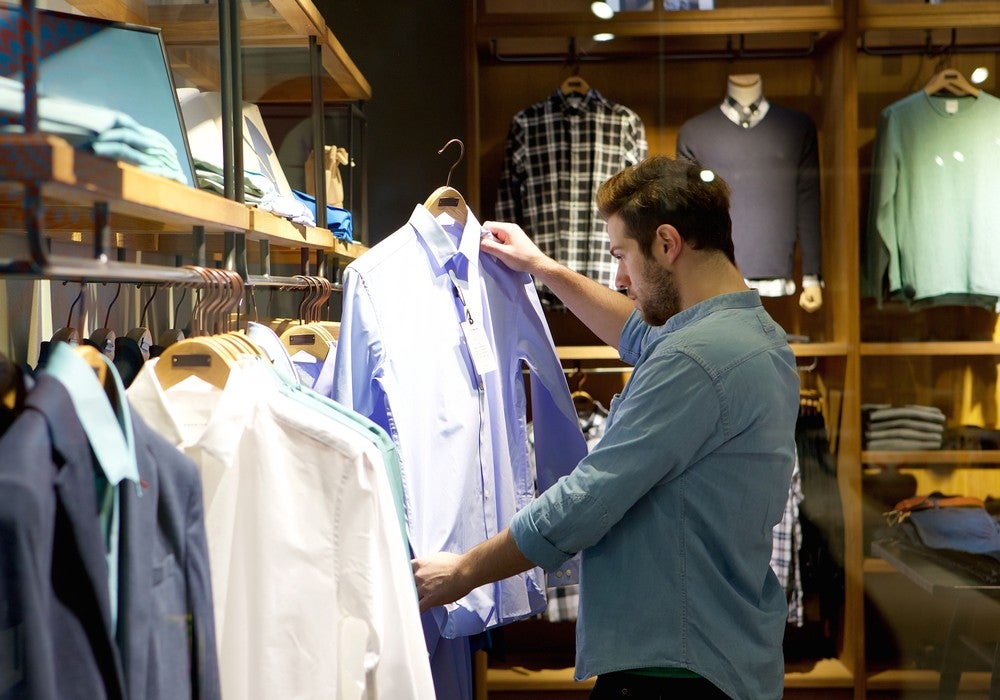Hold onto your fanny packs: A new survey finds that it’s men — not women — who prefer getting into their cars, driving to the mall, buying some fro-yo and actually (gasp) shopping. Women prefer the opposite: using mobile apps, comparison shopping first, and browsing the buffet-like glut of online deals like it’s some kind of Pornhub for home goods. What this means for “Women be shoppin’” memes, lazy stand up, and sitcoms where sadsack men hold purses while their wives try on 16 pairs of shoes per minute is yet to be seen, but the news is a subtle yet significant shift in the literature of tired gender stereotypes about purchasing consumer goods.
The survey was conducted by retail pricing company First Insight, who surveyed 1,000 shoppers about their habits, CNBC reported. They found that men haven’t embraced online shopping as much as women have because they prefer the traditional brick-and-mortar experience. Men also have fewer Amazon Prime accounts, and are less likely to do any online comparison shopping before venturing out to Best Buy. What’s more, they are more likely to frequent full-price retailers over those discount places women love so much.
“Men are destination drivers,” Greg Petro at First Insight told CNBC. “They go in stores to touch and feel. They like to a execute deal [at stores] and then bring items home with them.”
That language is important, because it’s still a distinctly masculine way of framing the shopping experience that underscores all our favorite stereotypes about how different men and women are. Make no mistake: Men still hunt and slay a toaster, and then drag that baby back home to the man cave to make sweet toast love to it. And it still fits nicely with the same justifications we use to argue that women have some kind of frivolous shopping gene that explains their habits, too: As gatherers, searching for bargains is an evolutionary mandate of the lady variety, or so we’re told.
But let’s not get confused here. The reality is just that women have a leg up on shopping because of decades of being primary caregivers who do the mundane work of stocking the home for everyone. Men are only recently coming into that role as more equal parents and partners. It makes broadly intuitive sense that they’d need a transition period to get up to speed with how to do this in the most efficient way — one women have had on lock for years as homemakers and the administrative assistant of the home.
Yet, for some reason, we still really care about making sure we define this in Venus and Mars terms. For instance, we know men go and buy stuff, of course, it’s just that it’s always made clear it’s buying, not shopping. Put another way: “Women are from Nordstrom’s; men are from Sears.” That assertion was based off a 2007 study that found that women love everything about the in-person shopping experience, whereas men are just getting in there, getting the shit, and getting out because they have something better to do.
If it was ever true, it’s not anymore. Recent studies find that men are increasingly doing more grocery shopping, too, and we tend to put that in the same oversimplified gendered terms. In 2017, NPD Group found that men are the primary grocery shopper in 41 percent of households, The Washington Post reported on a piece about how grocery stores treat men like knuckleheads. They wander into the store with no list, no meal plan, and only grab what they can remember they need. Women, on the other hand, have the kind of basic foresight it takes to know to buy twelve-packs of beer because they realize they will drink again tomorrow. Men, in contrast, buy a six pack, because that’s exactly the volume they were intending to consume in the next three hours.
I don’t think men are this idiotic, but experts perpetuate this in media-ready gendered sound bytes. “Men tend to be hunters: They want to kill something quickly, drag it out and feel successful,” Loyola Marymount marketing professor David Stewart told the Post. “Women, though, they’re thinking ahead and planning accordingly.”
Stewart continued:
Men also tend to spring for pricier cuts of meat and are more easily influenced by a brand’s name or reputation, Stewart said. They are more likely to buy what is easily visible and catches their eye. As a result, supermarkets have begun adding more special displays in their stores, and rethinking their organization.
While the First Insight survey is small at only 1,000 folks surveyed, it shows us that — again, in the broadest sense (there are always exceptions) — women are more evolved shoppers because we’ve been doing it for so long.
I think eventually we’ll reach an understanding that shopping style is based more on personality than gender. Some people enjoy shopping in person and trying things out. Others love the convenience of ordering online and sending back unwanted goods at no extra cost. Right now, in the infancy of gender progress, that still looks pretty different. Women are probably more likely to use online shopping and mobile apps because it’s easier and cheaper, not to mention that there are a million sites offering a million incentives targeting us every time we log in to any media site — Try the bra for free! Send the shoes back for free!
It’s likely that in due time, men, too, will realize it’s far easier to buy light bulbs online with free two-day shipping while simultaneously taking a shit. Until then, let them start dragging us to the mall, so we can hold their wallets while they test out the backyard grill. Then later, we can show them an online deal they can’t resist, and marry the best of both worlds to really make America great again: consumerism so efficient no one ever has to leave the house again.

